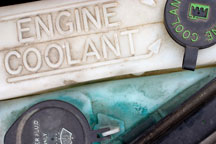
Engine Coolants Subcommittees
ASTM International Committee D15 on Engine Coolants has formed three new subcommittees: D15.22 on Non-Aqueous Coolants, D15.25 on Diesel Exhaust Fluid and D15.30 on Industrial Heat Transfer Fluids.
All interested parties are invited to join in the standards developing activities of these new subcommittees.
D15.22, Non-Aqueous Coolants
While there has been an increased interest in non-aqueous coolants by industry, there are not currently any ASTM standards in this area. D15.22 will begin to develop such standards.
"The envisioned standards for non-aqueous coolants would be performance standards, rather than ingredient standards, to allow for formulations that are not currently proprietary," says Jonathan T. Light, chief engineer, Evans Cooling Systems Inc., and chairman of D15.22. "Standards developed by D15.22 will be useful in assuring that the non-aqueous coolants covered by the standards can be relied upon to perform satisfactorily in engines." Light says that original equipment manufacturers for engines, as well as repair and service shops, will be the primary users of D15.22 standards.
There are currently two proposed new D15.22 standards: WK30376, Test Method for Viscosity of a Non-Aqueous Engine Coolant, and WK30377, Test Method for Pour Point of a Non-Aqueous Engine Coolant.
D15.25, Diesel Exhaust Fluid
Diesel exhaust fluid, often referred to as DEF, is required by many diesel engine-powered vehicles delivered after January 2010. More recent environmental standards issued by the U.S. Environmental Protection Agency have created more stringent emissions standards for agricultural, construction and forestry equipment. DEF is used to reduce nitrogen oxide emissions, which allows original equipment manufacturers to better meet these environmental standards.
Edward R. Eaton, chief engineer, Amalgatech, vice chairman, D15, and chairman, D15.25, notes that DEF is a nonhazardous substance consisting of two-thirds water and one-third urea that is used in vehicles equipped with selective catalytic reduction technology. When sprayed into exhaust in the presence of a catalyst, DEF reacts and changes nitrogen oxide gases into nitrogen gas and water.
"The most recent diesel emission reductions that were implemented in January 2010 require diesel vehicles to again significantly reduce harmful emissions of nitrogen oxide and particulate matter," says Eaton. "Selective catalytic reduction and DEF provide the most widely used technology to comply with these new regulations."
Eaton says that standards to be developed by D15.25 will include both laboratory and field determinations.
"The objective of the committee's work is to provide tests that result in producers and users being able to verify that the DEF they are using is the correct blend of urea and water and that the fluid contains no contaminates that can poison the sensitive selective catalytic reduction system," says Eaton. "This will result in trouble-free, low emissions vehicle operation."
D15.30, Industrial Heat Transfer Fluids
Members of D15 recognized that changes in the antifreeze industry, including new manufacturing technologies, improved inhibitor chemistries and recycling technologies would likely be adapted to the facilities industry as a natural course of innovation. Because D15 has experience developing standards that are technically similar to the facilities heat transfer industry, it was deemed appropriate that a new D15 subcommittee establish standards for industrial heat transfer fluids.
"Proposed standards for industrial heat transfer fluids will likely be a combination of chemical composition standards and performance tests," says John Panasewicz, founder and CEO, Clear Choice Antifreeze and G2 Solutions LLC, and chairman of D15.30. "Further, there are issues such as freeze point, burst point and viscosity parameters that will be addressed with new testing protocols specific to the needs of industry."
In addition, Panasewicz says that the construction industry has embraced the LEED (Leadership in Energy and Environmental Design) program, with professionals seeking to comply with higher environmental standards.
"The goal of D15.30 is to supply the industry with a set of appropriate standards for the fluids used in facility heating, cooling and freeze prevention applications," says Panasewicz.
Panasewicz says the primary users of standards to be developed by D15.30 would be building engineers; manufacturers of heating, ventilating and air conditioning equipment such as boilers, chillers and heat exchangers; and building maintenance professionals.
Panasewicz notes that the subcommittee is seeking a wide cross-section of industry professionals to participate in its work.
CONTACT Technical Information: (D15.22) Jonathan T. Light, Evans Cooling Systems Inc. • Sharon, Conn. • Phone: 860-435-2418 • Email: jtlight@comcast.net • (D15.25) Edward Eaton Sr., Amalgatech • Phoenix, Ariz. • Phone: 602-252-0280 • Email: edeaton@amalgatech.com • (D15.30) John Panasewicz, Clear Choice Antifreeze • Henderson, Colo. • Phone: 303-227-9900 • Email: johnp@clearchoiceantifreeze.com O ASTM Staff: Joe Koury • Phone: 610-832-9804 • Email: jkoury@astm.org O Upcoming Meeting: May 17-18 • May Committee Week • Anaheim, Calif.
 SN Home
SN Home Archive
Archive Advertisers
Advertisers Masthead
Masthead RateCard
RateCard Subscribe
Subscribe Email Editor
Email Editor